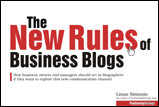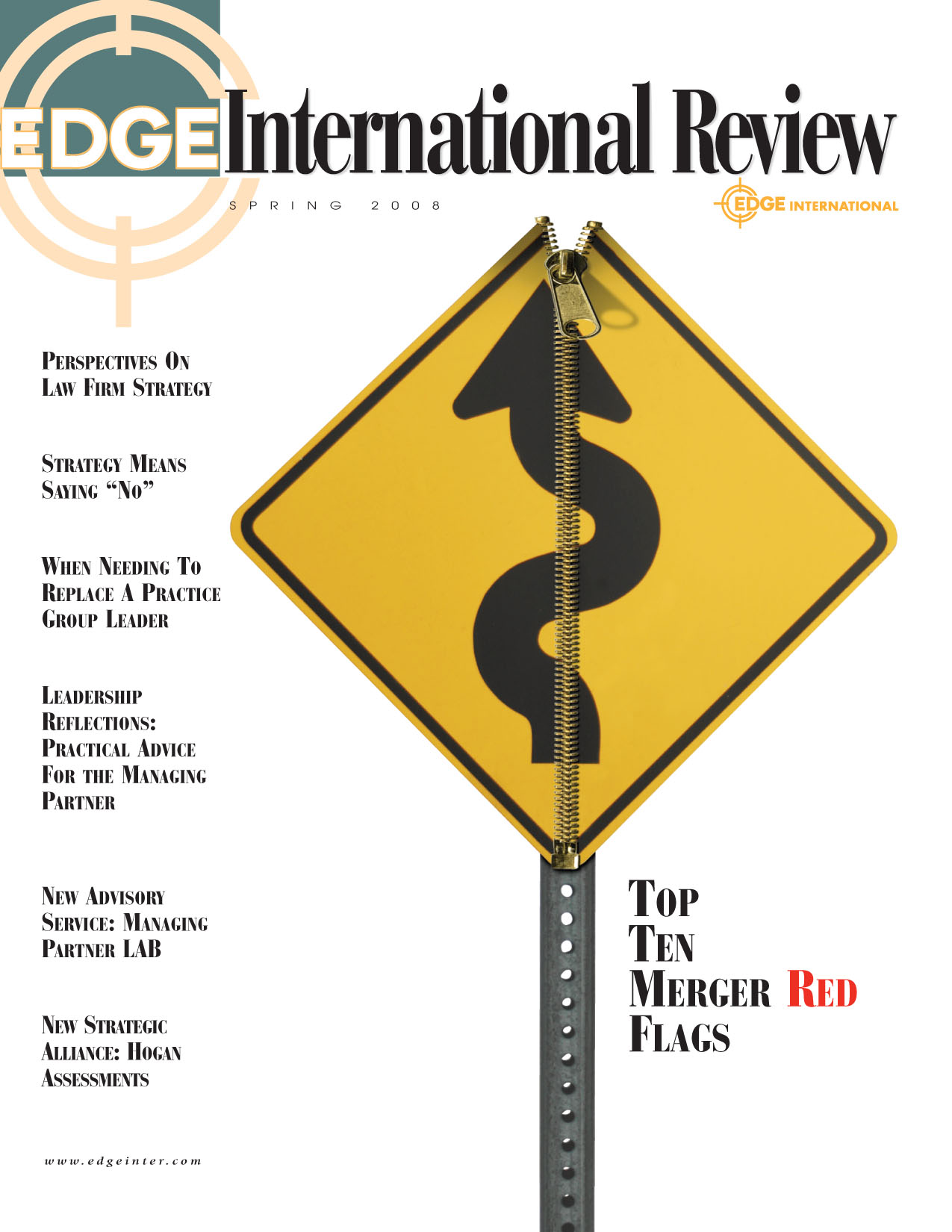
|
http://www.patrickmckenna.com/blog
Page << Prev 60 61 62 63 64 65 66 67 68 69 Next >> of 95
Post #311 - Monday, May 12, 2008
Handling The Chronic Complainer
Here is the latest question posed to our Managing Partner Leadership Advisory Board (The LAB):
 "I’ve been in this position for only a few months, but it seems that one particular partner has been in my office every week complaining about something. It’s either about how I should be exercising more management authority over some other partner or the way certain things are being done. Thankfully, this character is a productive contributor and does not appear to be sharing his gripes with everyone else. I’m quite comfortable dealing with any partner who’s not pulling their weight, but this constant whining is definitely getting to me. What do you do with partners like this?" "I’ve been in this position for only a few months, but it seems that one particular partner has been in my office every week complaining about something. It’s either about how I should be exercising more management authority over some other partner or the way certain things are being done. Thankfully, this character is a productive contributor and does not appear to be sharing his gripes with everyone else. I’m quite comfortable dealing with any partner who’s not pulling their weight, but this constant whining is definitely getting to me. What do you do with partners like this?"
Read the entire question and response: Handling The Chronic Complainer [PDF Version]
The LAB was formed as a resource to provide pragmatic advice to assist new managing partners with their critical burning issues and help them succeed. The LAB is comprised of the following distinguished current and former law firm leaders: Angelo Arcadipane (Dickstein Shapiro LLP); John Bouma (Snell & Wilmer LLP); Brian K. Burke (Baker & Daniels LLP); Ben F. Johnson, III (Alston & Bird LLP); John R. Sapp (Michael Best & Friedrich LLP); Keith B. Simmons (Bass Berry & Sims PLC); William J. Strickland (McGuire Woods LLP); Harry P. Trueheart, III (Nixon Peabody LLP); together with Patrick J. McKenna (Edge International).
Post #310 – Friday, May 9, 2008
Your New Lateral’s First Days
 I have seen a number of instances now where lateral partners feel that their voices are not being heard, and that no recognition is being given to their contribution. It is critical, that as a managing partner, you build institutional links with your laterals from day one, minute one. Consider: I have seen a number of instances now where lateral partners feel that their voices are not being heard, and that no recognition is being given to their contribution. It is critical, that as a managing partner, you build institutional links with your laterals from day one, minute one. Consider:
Do you involve peers in the selection process? The hiring of any lateral should always involve partners – not just from the location where the lateral is joining, but from across your firm. Latham & Watkins is notoriously good at this and requires that any new lateral candidate meet with future colleagues in up to 10 offices before they are accepted.
Do you make new laterals feel welcome? Do you do things that communicate “We’re glad you’re here” or is it more “Alright let’s get to work.” Ask new laterals who’ve been with you for a couple of months how welcome they felt the first day, the first week, the first month. Then ask them what you could do to create a more welcoming experience.
Do you make it easy for new laterals to tell you how things are going? Although some people have no problem letting you know what they think, regardless of the context, when you’re trying to make a good impression with your new lateral, you’re less likely to express any concerns you may have or spend the time making sure that expectations are absolutely clear. One client of mine works out a joint business plan, in writing, with the lateral, either before or immediately after joining so that what is expected of both sides is clearly set out. In those firms that have a “Suck it up” and “Sink or Swim” mentality, laterals learn quickly that it’s best to keep your mouth shut and make the best of it. Those firms never hear about what it is that they do that alienates their new laterals . . . until it’s too late.
Do you connect your new attorneys with the big picture? The more your lateral understands the mission and goals of your firm, the more engaged that lateral will be from the outset. The management team at Snell & Wilmer did this by creating an extensive video presentation to introduce new laterals to the firm’s vision and uniqueness. Alternatively, if the centerpiece of your orientation is logistical minutiae, you diminish people’s enthusiasm and desire to make a difference.
Do you show them how much they matter? Engaging people from the outset requires more than just communicating “This is what we’re about and why we’re a great firm”. It must also include “This is how YOU can fit in and help make it happen.” Communicating this is especially important if you want to attract and retain Gen Y professionals, who place an extremely high priority on work that matters and being able to make a difference.
An effort to really encourage effective internal communication is a requirement that I see constantly ignored.

Post #309 - Friday, May 9, 2008
Some Stunning Economic Facts
 Newspapers tell us that the ‘worst is behind us.’ The housing crisis is over, says the Wall Street Journal. One always wonders what the real story is . . . Newspapers tell us that the ‘worst is behind us.’ The housing crisis is over, says the Wall Street Journal. One always wonders what the real story is . . .
Further to my earlier posts (Post #289, 285, 269, etc) my friend Gary who is an economist, knows my passion for getting a behind the scenes look at what is going on with the economy, graciously sends me an e-mail update every so often. Here is his latest uncovering:
On the household front, millions of homeowners haven’t even finished paying their heating bills from last winter, and over six million Americans asked for energy assistance funds so their power wouldn’t be shut off. (In California alone, 1.7 million households are behind on their utility payments.)
Signs of the stretched consumer include the following stunning facts:
• Home equity loans have a seven percent delinquency;
• Sub-prime mortgages, past due over 60 days, are pushing 14 percent;
• Over one million homes are in foreclosure and three million more are empty, and up for sale;
• Ten million homes have mortgage balances greater than their value. (No wonder some homeowners are walking away from them);
The Federal Reserve System has posted some interesting maps. This one, plus two others, appeared on the web page of Ben Bernanke's May 5 speech calling on Congress to use taxpayer money to bail out renters who took advantage of the low rates produced by Greenspan's FED. The FED created the housing bubble. Now Bernanke wants taxpayers to keep the popped bubble from deflating even more. The popped bubbles threaten to bankrupt some large commercial banks that put up the money for the bad loans.

Any family in a red-colored county who bought a home in 2005 through early 2007 has suffered capital losses so great that it is unlikely that the family will ever get its money back -- money in today's purchasing power, I mean. The family bought a dream just as the dream was about to end.
MEANWHILE:
• In the auto market, 25 percent of all car loans are higher than the car is worth. (The average balance these cars are underwater for is $4,300!)
• Jobs are also falling off a cliff. Currently, 2.7 million workers have exhausted their unemployment benefits.
• The rising price of food has forced a record 28 million Americans onto food stamps.
That said, more than a million Americans are being fed and housed, courtesy of state, local and federal governments. They’re the lucky ones . . . paying no mortgages . . . losing no jobs; they don’t even have to buy bread. Still, life in U.S. prisons is probably no picnic.

Post #308 - Wednesday, May 7, 2008
New Rules of Business Blogs
 Last Friday, David Maister informed us that Linas Simonis has just published an e-book called The New Rules of Business Blogs AND it is a great read. Last Friday, David Maister informed us that Linas Simonis has just published an e-book called The New Rules of Business Blogs AND it is a great read.
For some time now I’ve been personally perplexed at seeing these blogs that simply write about a content found in other sites. Just go to any blog and have a look at the last ten postings and count how many of them simply post links without any truly meaningful or substantive comments. What mindless IDIOCY! It is for this reason that I have been happy to loudly proclaim, for the past six years, that what I do here is not your typical blog. Now finally, someone sets the record straight. According to Simonis . . .
• The “old rules of blogs were all about traffic, Technorati ranks, number of comments, appreciation, buzz . . .”
• “Blogs are not newspapers. So forget the rule: If you have nothing to say, collect and post some links to other sites.”
• “Posts containing only links are spam coming through the RSS reader.”
• “Forget just traffic. It’s for kids. Or for Technorati rankers. Or for prologgers, whose business is Google ads.”
Instead Simonis counsels, by sacrificing traffic and concentrating instead on your targeted readers you will “build a community of evangelists.” The new rule of the business blog: It’s all about creating the impression that you are the specialist in your field, to demonstrate your specialization and your passion. Post only when you have something to say in your specialist area that will be helpful to your audience.
And while I’m fully conscious that I have not added any substantive content in this posting, I am thankful to David for bringing this little e-book to my attention. It is well worth reading.
Post #307 - Thursday, May 1, 2008
More Feedback On EIR
According to one of my partners in a discussion with Michael Saunders, Chairman of Spencer Fane, “Mike LOVED our latest EIR and especially commented on Perspectives on Law Firm Strategy and Strategy means Saying NO.”
Meanwhile I received a nice note from Kenneth Henderson in New York:
“I am the Chairman of Bryan Cave's Strategic Planning Committee. Don Lents, the chairman of the firm, has sent me copies from time to time of selected pieces from EDGE International Review. I have found it quite useful in my role.”
AND this today from Richard Wolf, COO at Parker Poe:
I was in a meeting with Bill Farthing our Managing Partner today when I noticed his copy of Edge International Review. I had a chance to browse through it and thought that I might see if I could prevail upon you to add me to your distribution list. The magazine is EXTREMELY well done and has some very timely and interesting articles.
Thank you gentlemen. We appreciate all of your gracious feedback!!! Our Summer issue is now currently in progress.
Post #306 – Friday, April 25, 2008
Who Do You Trust?
According to their official party line, Egon Zehnder International specializes in assessing and recruiting business leaders with outstanding track records who will create competitive advantage and sustainable value. They are a one-firm firm with 370 consultants, operating from 62 offices in 37 countries. To me this firm is most notable for their work on management appraisal systems, on new CEO transitions and on evaluating the human capital in organizations. They have been the subject of a Harvard Business School case, identified for best practices in my friend Suzanne Lowe’s book, Marketplace Masters and used as an example in one of Daniel Goleman’s books on emotional intelligence.
As a direct result of my work with managing partners, I am pleased to be a member of Egon Zehnder’s ‘Club of Leaders’ and as such collaborate on various research studies and have access to the findings before those studies are finally published. Our most recent survey concerned the topic of trust, was conducted from February 15 to March 15, and represents the views of over 1200 responses from all over the world.
There are some interesting findings:
 • Professional advisors enjoy a level of trust in the USA (53%) and the Netherlands (52%) that is noticeably higher than in other countries (40% on average). The business leaders surveyed are much less likely to trust people outside of their professional circles: Scientists or doctors, for example, were only named as trusted persons by 14% or 13% of top managers respectively. These results vary widely from country to country. For example, in Australia doctors are considered trustworthy (25%), whereas scientists are not (3%). • Professional advisors enjoy a level of trust in the USA (53%) and the Netherlands (52%) that is noticeably higher than in other countries (40% on average). The business leaders surveyed are much less likely to trust people outside of their professional circles: Scientists or doctors, for example, were only named as trusted persons by 14% or 13% of top managers respectively. These results vary widely from country to country. For example, in Australia doctors are considered trustworthy (25%), whereas scientists are not (3%).
• For 92% of those surveyed, relationships based on trust contribute significantly to lasting business success. However, regional differences can be seen in how such relationships develop. Top executives in India, the USA and Germany believe that trust grows slowly, built on shared projects and experiences. In contrast, managers in Australia, Great Britain and, above all, the Netherlands, are often of the opinion that such experiences are not necessary
• Executives gave very different responses when asked what sort of behavior would destroy their trust in a person. Personal weaknesses such as dishonesty, greed or manipulativeness are usually penalized by American and British executives with a withdrawal of trust. A large majority believes that once lost, trust can only be regained with difficulty. Business leaders from Switzerland, France and Germany emerge as especially sensitive in this respect in their answers. Their colleagues in India and Australia, on the other hand, are not as likely to see a loss of trust as irreparable.
• Most of the management elite think their own profession is not perceived positively by the general public. Only 18% believe that they enjoy trust in their own countries. Germans in particular (5%) see themselves as having a negative image. But in the USA, too, only one in ten believes that they are seen as trustworthy by the public. In contrast, a striking 50% of respondents from India think corporate leaders have a good reputation.
Shoot me an e-mail if you would like to receive and read a copy of this complete 34-page research report.
Post #305 – Monday, April 21, 2008
Being Client Focused
Further to my post #299 of April 10, this from an EIR reader:
 I enjoyed the strategy piece in the Spring issue of your Edge journal. Your magazine arrived following an RFP pitch that I observed where we didn’t do that well, and I believe precisely because of what you identified as too much focus on our methodology and past success and not enough focus on the prospect. I enjoyed the strategy piece in the Spring issue of your Edge journal. Your magazine arrived following an RFP pitch that I observed where we didn’t do that well, and I believe precisely because of what you identified as too much focus on our methodology and past success and not enough focus on the prospect.
RFP Presentations are particularly challenging, no matter how well you’ve rehearsed. Rehearsed? Yes, that is one of the things I find that law firms fail to do and fail to do with some friendly skeptics in the rehearsal room, that are in attendance specifically to help identify where your presentation could be improved.
A couple of other points I’ve learned:
• Start and end with the client. Develop your presentation to open and close with client-specific insights and observations (notice that I used the term “client” rather than prospect that’s because . . .);
• present as if you already have been retained. Focus on the client’s problem or situation and propose solutions, not your firm’s theoretical expertise. Ask the questions that you would ask at a kick-off meeting (yes, spend more time asking questions then trying to impress);
• ask questions and listen to the client. Use the precious pitch time you have with this potential client to boost your knowledge of their needs and goals. Repeat what you hear in the client’s own terms to demonstrate and confirm your understanding; and
• finally, try to deliver value. Provide this client with at least one important piece of information to help them focus their goals, advance their thought process, prepare for upcoming changes or better manage their legal process.
Post #304 – Monday, April 21, 2008
Recommended By JAG
Imagine my surprise when I came across a recent issue, Volume 34, Number 2, of The Reporter (The Judge Advocate General's Corps), and found my First 100 Days: Transitioning A New Managing Partner was cited as recommended reading for JAG leadership:
“At first glance this work seems an odd fit for the military environment, targeted to the world of for-profit law partnerships, million-dollar prima donna employees, and clients auditioning firms for each project. But there are deep similarities as attorneys grow into leaders, managing law practices with a variety of personalities, constrained resources, and a demanding clientele.
An hour invested will reward the reader with insights on management and leadership – with the immediacy of taking key actions within the first 100 days. Many of the practical principles and suggestions transcend a particular setting and are easily adapted to our practice.”
Post #303 - Friday, April 18, 2008
Back In The LAB
My role in initiating and now serving as Co-Chairman of The Managing Partner Leadership Advisory Board (The LAB) has been particularly busy as we continue to receive a number of interesting inquiries and notes. Here is an interesting question:
 "It would seem that many firms have a firm Chair and a managing partner. While this division of labor may make sense, I suspect that the skills involved are quite distinct. Should firms have both a chairman and a managing partner? Should what appears to be a common policy of automatically promoting the managing partner to firm chair at the end of the managing term, be the best way to go? What is your group's view on the right division of responsibilities between a firm chair and a managing partner?" "It would seem that many firms have a firm Chair and a managing partner. While this division of labor may make sense, I suspect that the skills involved are quite distinct. Should firms have both a chairman and a managing partner? Should what appears to be a common policy of automatically promoting the managing partner to firm chair at the end of the managing term, be the best way to go? What is your group's view on the right division of responsibilities between a firm chair and a managing partner?"
Read the entire question and response: Double Team At The Top [PDF Version]
The LAB was formed as a resource to provide pragmatic advice to assist new managing partners with their critical burning issues and help them succeed. The LAB is comprised of the following distinguished current and former law firm leaders: Angelo Arcadipane (Dickstein Shapiro LLP); John Bouma (Snell & Wilmer LLP); Brian K. Burke (Baker & Daniels LLP); Ben F. Johnson, III (Alston & Bird LLP); John R. Sapp (Michael Best & Friedrich LLP); Keith B. Simmons (Bass Berry & Sims PLC); William J. Strickland (McGuire Woods LLP); Harry P. Trueheart, III (Nixon Peabody LLP); together with Patrick J. McKenna (Edge International).
Post #302 - Friday, April 18, 2008
New Book Testimonial
It has been my great pleasure to provide personal testimonials for a number of great books this Spring and here is the latest one that is well worth you purchasing:
 Book Testimonial: Book Testimonial:
The Lawyer’s Guide to Collaboration Tools and Technologies
Smart Ways To Work Together
Dennis Kennedy and Tom Mighell
There is an old adage that one can either work hard or work smart . . . you have a choice. And we would all choose working smart, but once having made that obvious decision, you then have to figure out how. The good news is that Kennedy and Mighell have now produced the most comprehensive playbook, whether you are a solo, large law firm practitioner, or working within a legal department, for how to choose and use the right technology tools to ‘smartly’ collaborate. And for those who know that collaboration is a profoundly human endeavor, the authors identify all kinds of practical and cultural issues to watch for. This is one of those few texts that will be dog-eared throughout, from continued reference.
Patrick J. McKenna, author of Herding Cats, First Among Equals and First 100 Days: Transitioning A New Managing Partner
Page << Prev 60 61 62 63 64 65 66 67 68 69 Next >> of 95
|
|


 Ashridge House
Ashridge House  11226 - 60 Street
11226 - 60 Street  Edmonton, Canada
Edmonton, Canada  T5W 3Y8
T5W 3Y8